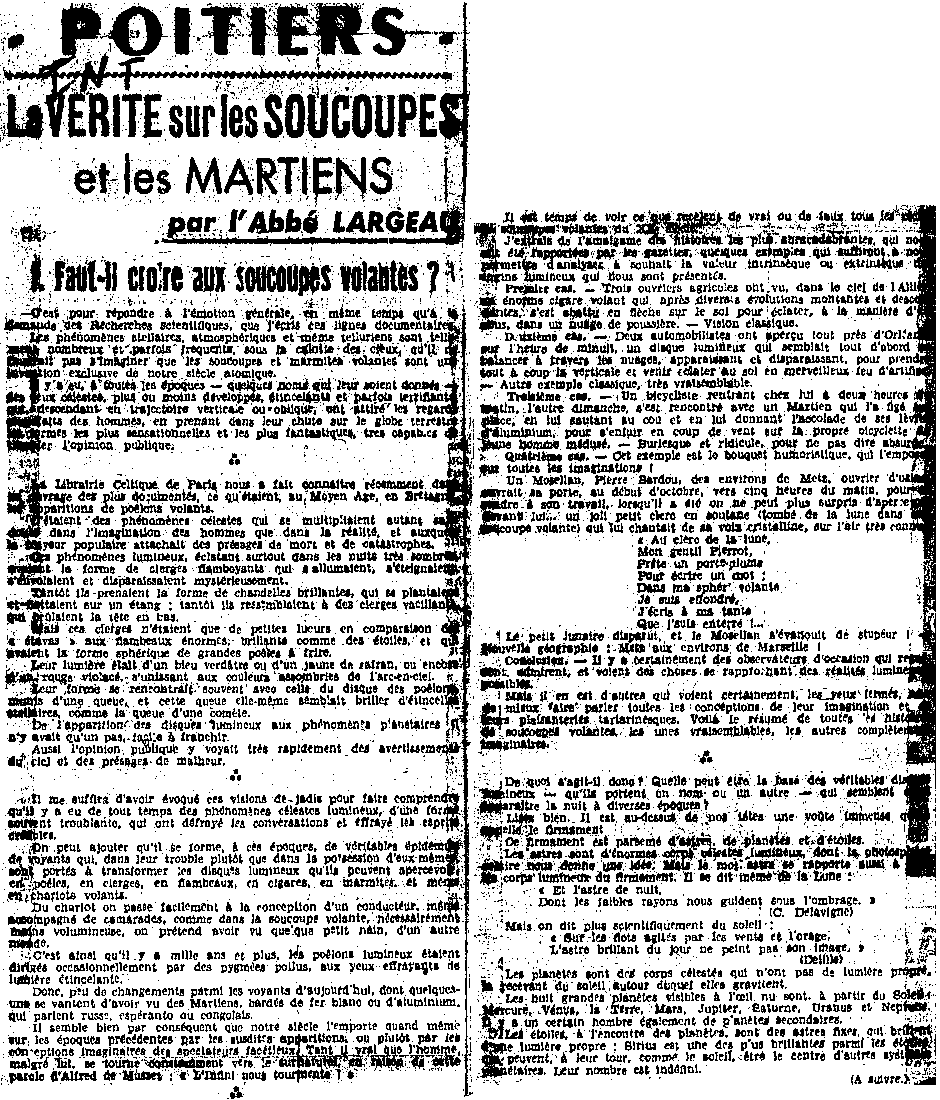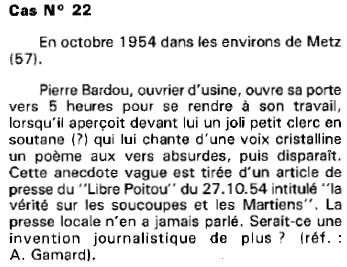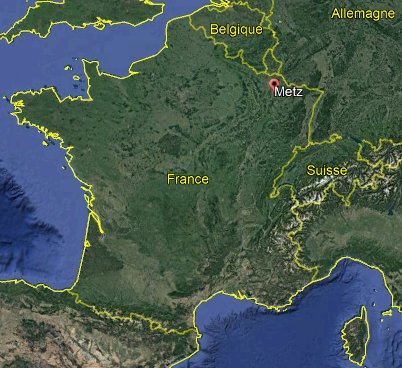
The index page for the 1954 French flap section of this website is here.
Reference for this case: Oct-54-Metz.
Please cite this reference in any correspondence with me regarding this case.
The influx of stories of encounters with "Martians" in France in 1954, reported sometimes with some benevolence in the Press, also prompted mocking articles. Thus, in the regional newspaper Le Libre Poitou for October 27, 1954, one "abbot Largeac" ensured to tell the "truth on the saucers and the Martians" from examples, not sourced and not localized, which he had visibly invented by caricaturing the stories of the time.
The most pathetic "example" he gave was that, according to him, a resident of the Metz area in the Moselle, Pierre Bardou, a factory worker, had opened his door at the beginning of October around 5 a.m., to get to work, "when he was most surprised to see in front of him... a pretty little clerk in a cassock (fallen from the moon in a flying saucer) who was singing to him in his crystalline voice, to the well-known tune:"
"-In the moonlight,
My nice Pierrot,
Lend me your pen
To write a word. In my flying sphere
I collapsed.
I'm writing to my aunt
How buried I am! ...
The abbot claimed that the "little moonman disappeared, and the Mosellan fainted from amazement!"
The anecdote was listed in the years 1980 - 1990 by the "skeptical" ufologist Raoul Robé, wondering "Is this one more journalistic invention?"; but it was also included as if it were serious case in at least two foreign catalogs.
[Ref. llp1:] NEWSPAPER "LE LIBRE POITOU":

|
by abbott LARGEAC
- It is to answer the general emotion, and at the same time at the request of the scientific Research, that I write these documentary lines.
The stellar, atmospheric and even telluric phenomena are so numerous and sometimes frequent [sic!] under the cap of the skies, that one should not imagine that the flying saucers and flying pots are an exclusive invention of our atomic century.
There was, at all the times - whatever names they are called - celestial fires, more or less developed, sparkling and sometimes terrifying, which, going down in vertical or oblique trajectories [redundancy] attracted the amazed glances of men, by taking in their fall on the terrestrial globe the most sensational and most fantastic forms, very able to disturb the public opinion.
The Celtic Library of Paris made us known recently in a most documented book, what were in Brittany, in the Middle Age, the appearances of flying pans.
They were celestial phenomena that multiplied as much inside the imagination of the men as in the reality, and to which popular fright attached predictions of death and of catastrophes [meteors and comets].
These luminous phenomena burst especially in the very dark nights, taking the shape of blazing church candles [the author is a clergyman] which ignited, died out, flew away and disappeared mysteriously.
Sometimes they took the shape of brilliant candles which were planted and floated on a pond [will-o'-the-wisps]; sometimes they resembled wavering candles which burned their top upside down.
But these candles were only small gleams compared to "étavas" of enormous torches, shining like stars, and which had the shape spherical of large frying pans [meteors].
Their light was of a greenish blue or a saffron yellow, or of a purplished red, uniting with the obscured [?] colors of the rainbow.
Their form was often confused with that of the disc of a pan provided with a tail and this tail [the trail of the meteors] itself seemed to shine of stellar sparks, like the tail of a comet.
From appearance of the luminous discs to planetary phenomena, there was only only one step, easy to cross.
Therefore the public opinion saw in this very quickly warnings of the heavens and sign of misfortune.
It will be enough for me to have evoked these visions of the past to render comprehensible that there were from immemorial time luminous celestial phenomena, of an often disconcerting shape, which defrayed the conversations and frightened the credulous minds.
One can add that it formed, at these times, true epidemics of fortune-tellers that, in their disorder rather than in the possessions of themselves, are drawn at changing the luminous discs that they can see into stoves, candles, torches, cigars, pots and even flying carriages.
From the carriage one passes easily to the notion of a driver, even accompanied by comrades, as in the flying saucer, necessarily less bulky [!], where one claims to have seen some small dwarf of another world.
Thus thousand years ago and more, luminous pans were directed occasionally by hairy Pygmies, with the alarming eyes of shining light.
So, there are few changes among the fortune-tellers of today, of which some are bragging about having seen Martians, dressed of tin or of aluminum, who speak Russian, Esperanto or Congolan.
It thus does really seem that our century nevertheless wins over the previous times by the aforesaid appearances, or rather by the imaginary designs by facetious witnesses. It is so true that man, in spite of himself, obstinately turns to the supernatural [the concept of Martians visitors does not belong to the supernatural] because of this word of Alfred de Musset: "the infinite one torments us!"
It is time to see what truth or forgery is concealed in all the accounts of flying saucers of 20th century [ufology].
I extract from the bunch the most silly stories that were brought back to us by the gazettes, some examples which will be enough [error] to enable us to analyze as deep as we wish the intrinsic value or extrinsic value of the luminous machines which are presented to us.
First case. -- Three farm laborers saw, in the sky of Allier, an enormous flying cigar which after various rising and downward evolutions, fell down like an arrow on the ground to burst, in the manner of a bombshell, in a cloud of dust. Traditional vision [not].
Second case. -- Two motorists saw very close to Orleans at midnight, a luminous disc which first of all seemed to swing through the clouds, appearing and disappearing, to take suddenly the vertical and to come to burst on the ground in a marvelous fireworks. Another traditional [not], very probable example.
Third case. -- A cyclist returning at his place at two o'clock in the morning, the other Sunday, met with a Martian who froze him on the spot, while jumping at him to the neck and giving him the accordance of his aluminium lips, to flee in a blow of wind on the very bicycle of our stunned man. -- Burlesque and ridiculous, if not certainly absurd [the author made this up entirely, putting together the Mazaud case and other cases!].
Fourth case. -- This example is the humorous bouquet [selected precisely for that], which overrides all imaginations!
A native of the Moselle region, Pierre Bardou, of the surroundings of Metz, factory worker, opened his door, at the beginning of October, around five hours of the morning, to go to his work when he was not little surprised to see in front of him... a pretty junior clerk dressed in y cassock (fallen from the moon in a flying saucer) who sang with his crystalline voice for him, the very well known tune:
"-Au clair de la lune [in the moonlight],
Mon gentil Pierrot, [my sweet Pierrot]
Prête-moi ta plume [lend me your pen]
Pour écrire un mot [to write a note].
Dans ma sphère volante [in my flying sphere]
Je suis effondré. [I am devastated]
J'écris à ma tante [I write to my aunt]
Que j'suis enterré! [that I'm buried in the ground]...
The small moony disappeared, and the native of the Moselle region faints with stupor!
New geography: But around Marseilles! [?]
Conclusion. -- There are certainly occasional observers who look at, admire, and see things approaching possible luminous realities.
But there are other who certainly see with closed eyes, in order to better utter all the conceptions of their imagination and their tartarinesque jokes. Here is the summary of all [not] stories of flying saucers, the ones probable [certainly], other completion imaginary [certainly].
What is it then? [discussion coming after the conclusion.] What can be the base of the true luminous discs - whether they bear a name or another - which seem to appear during the night [not] at various times?
Read well. There is above our heads an immense vault [not] called the heavens.
This firmament is strewn with stars, planets and stars ['astres' and 'étoiles', he wrote. Of course astres is just a synonym of étoiles, hence "stars and stars"].
The stars are enormous celestial luminous bodies [!], which photography gives us an idea of. But the word stars also refers to luminous elements in the firmament. It is even said of the Moon:
"And the star of the night
Which weak rays guide us in the shade."
(C. Delavigne)
But one says more scientifically [!] of the sun:
"On the waters agitated by the winds and the storm,
the shining star of the day does not paint its image."
(Delilla)
The planets are celestial bodies which do not have their own light, receiving it from the sun around of which they revolve [Certainly].
The eight large planets visible with the naked eye are, starting from the Sun: Mercury, Venus, Earth, Mars, Jupiter, Saturn, Uranus and Neptune [The Abbot speaks the truth.] There is a also certain number of secondary planets.
The stars, contrary to the planets, are fixed stars, which shine of their own light: Sirius is one of most brilliant among the stars which can, in their turn, like the sun, be the center of other planetary systems. Their number is indefinite [Indeed; there is more than 100 000 000 000 stars in our galaxy].
(To be continued.)
[Ref. gep1:] UFOLOGY GROUP "GEPO":
| ------ | ( ) | Metz (Moselle) |
[Ref. rre1:] RAOUL ROBE:

|
Case # 22
In October 1954 in the surroundings of Metz (57)
Pierre Bardou, factory worker, opens his door towards 5 o'clock to return to his work, when he sees in front of him a pretty junior clerk in a cassock (?) who sings to him in a crystalline voice a poem with absurd verses, then disappears. This vague anecdote comes from a Press article in the "Libre Poitou" for 10/27/.54 headlined "the truth on the saucers and the Martians". The local press never spoke about it. Could this be one more journalistic invention? (ref.: A. Gamard).
[Ref. rre2:] RAOUL ROBE - CNEGU:
Case nr. 17:
In October 1954, near Metz (57), Pierre Bardou, factory worker, opens his door around 5 am to go to work, when he sees in front of him a pretty little clerk in a cassock who sings to him in a crystalline voice a poem with absurd lines, then disappears.
Explanation: This vague anecdote taken from a press article from another region, the local press never spoke about. Could this be another journalistic invention?
Source: Le Libre Poitou of 10/27/1954 "The truth about saucers and Martians" (A.Gamard).
[Ref. ars1:] ALBERT ROSALES:
104.
Location. Near Metz, France
Date: October 1954
Time: 0500A
Factory worker Pierre Bardou was walking on his way to work when he saw in front of him a small monk-like figure wearing a dark smock that chanted in a bizarre "crystalline" voice, absurd verses and poems. The figure suddenly disappeared.
HC addendum
Source: Raoul Robe, Regional Catalogue
Type: E
[Ref. tai1:] "THINK ABOUT IT" WEBSITE:
Location: Near Metz, France
Date: October 1954
Time: 0500A
Factory worker Pierre Bardou was walking on his way to work when he saw in front of him a small monk-like figure wearing a dark smock that chanted in a bizarre "crystalline" voice, absurd verses and poems. The figure suddenly disappeared.
Source: Raoul Robe, Regional Catalogue

|
Obvious invention by abbot Largeac.
(These keywords are only to help queries and are not implying anything.)
Metz, Moselle, Pierre Bardou, small, character, monk, singing, voice
[----] indicates sources that are not yet available to me.
| Version: | Created/Changed by: | Date: | Change Description: |
|---|---|---|---|
| 0.1 | Patrick Gross | February 10, 2005 | First published. |
| 1.0 | Patrick Gross | March 1, 2010 | Conversion from HTML to XHTML Strict. First formal version. Addition [llp1]. |
| 1.1 | Patrick Gross | August 19, 2010 | Addition [rre1]. |
| 1.2 | Patrick Gross | October 7, 2014 | Addition [tai1]. |
| 1.3 | Patrick Gross | January 30, 2021 | Addition [tai1]. |
| 1.4 | Patrick Gross | April 1, 2022 | Additions [gep1], Summary. |